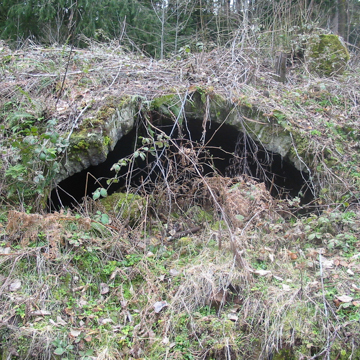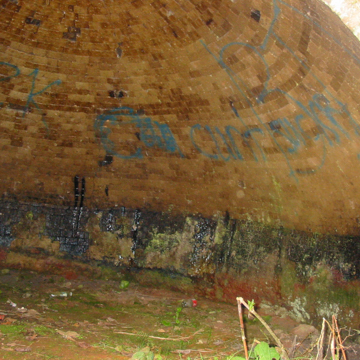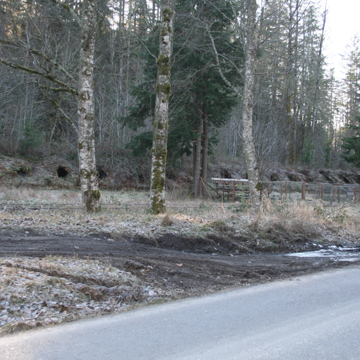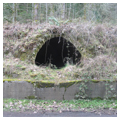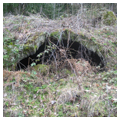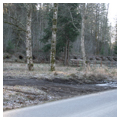Built in a small valley at the foot of the Cascades just east of the town of Wilkeson are 30 of the 160 original coal-burning coke ovens constructed between 1885 and 1914 by the Northern Pacific Railroad. Designed to support coal mining near the Carbon River and some 21 miles southeast of Tacoma, the beehive-shaped ovens were built in pairs, leading approximately three-tenths of a mile to a now-abandoned Northern Pacific Railroad line that provided transportation to foundries and other industries in Seattle, Tacoma, and Portland, where coke was often used in the process of turning iron ore into steel. They are excellent reminders of the industrial heritage that helped build the state of Washington.
The Wilkeson Coke Ovens were built to capitalize on rising industrial activity in the nineteenth-century Pacific Northwest. Coal was initially discovered in Wilkeson in 1862, and mining began in what was originally called the “Puyallup River Coal Field” in 1873. The bituminous coal mined in this area quickly gained a reputation for its ability to burn quickly and leave few impurities, making it perfect for widespread industrial application. Acting upon this, in 1876, Samuel Wilkeson, who served as secretary of the Northern Pacific Railroad and for whom the town was named, spearheaded an effort to construct a branch line to the mines in order to efficiently move coal for distribution to the larger cities of the Puget Sound. Emphasis at Wilkeson soon shifted to producing “coke” from the mined coal by means of beehive-shaped ovens constructed along the railroad tracks, thereby completing the refinement process in the field. When the coke cooled, it could be moved directly onto rail cars for shipment to various foundries in the Puget Sound region—or onto waiting ships bound for San Francisco.
The ovens were constructed of brick imported from the Heathfield Fireclay Works in Lanarkshire, Scotland. Each brick was beveled to help form the distinctive beehive oven shape. No mortar was used: a six-inch layer of concrete covers the exterior of each oven and a continuous vertical wall made of local sandstone, from a nearby quarry in Wilkeson, surrounded them. Insulation was provided by a layer of red clay added between the ovens and the vertical sandstone wall. A small hole on top of each oven allowed for the coal to be loaded for firing, a process that took between 48 and 72 hours before the impurities of the coal were removed. The finished ovens were approximately 8 feet tall and 12 feet in diameter.
The Tacoma Coal and Coke Company built the first 25 beehive ovens at Wilkeson in 1885—the first on the Pacific Coast. Another 50 ovens were constructed by the Wilkeson Coal and Coke Company in 1891, and several more were added in later years. With the advent of lead and copper smelting, the demand increased, and at the height of production in 1916 during World War I, 160 ovens were in operation producing 125,872 tons of coke. Work in the coal fields and the ovens was undertaken by thousands of immigrants, most of whom were European.
Demand declined with changes in technology, however, and coal mining at the site ceased altogether in 1937. The sandstone walls were removed during the late 1940s for wall construction in nearby Orting. Over time, soil and vegetation grew to both expose and cover many ovens, while several others collapsed. A number of them display the effects of intense heat in the discoloration, fusing, and melting of the interior bricks.
When the ovens were abandoned, Pierce County acquired the land and plans were made to develop a park. The overall site was deeded to the town of Wilkeson in 2000 and today the remaining ovens, in a ruined state, are part of Wilkeson’s “Coke Oven Park,” occupying about 9.5 acres east of town. The site is listed on the National Register of Historic Places and the Washington Heritage Register, and in 2010 it was listed as one of the state’s eight most endangered sites by the Washington Trust for Historic Preservation.
References
Hogerhuis, Donna, “Town of Wilkeson Coke Oven Park,” Pierce County, Washington. Pierce County Register of Historic Places Nomination Form, 2013. Landmarks and Historic Preservation Commission, Tacoma, Washington.
Washington State Office of Archaeology and Historic Preservation. Built in Washington: 12,000 Years of Pacific Northwest Archaeological Sites and Historic Buildings.Pullman: Washington State University Press, 1989.
Washington State Office of Archaeology and Historic Preservation, “Coke Ovens,” Pierce County, Washington. National Register of Historic Places Inventory–Nomination Form, 1974. National Park Service, U.S., Department of the Interior, Washington, D.C.
“Wilkeson Coke Ovens.” Town of Wilkeson. Accessed on September 25, 2017. http://www.townofwilkeson.com/.









